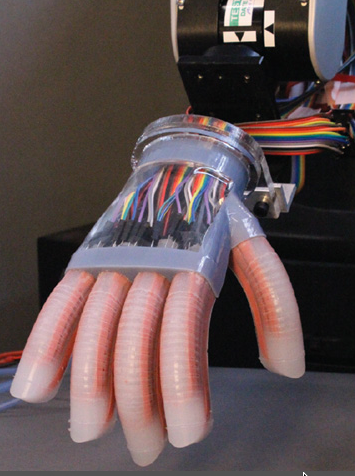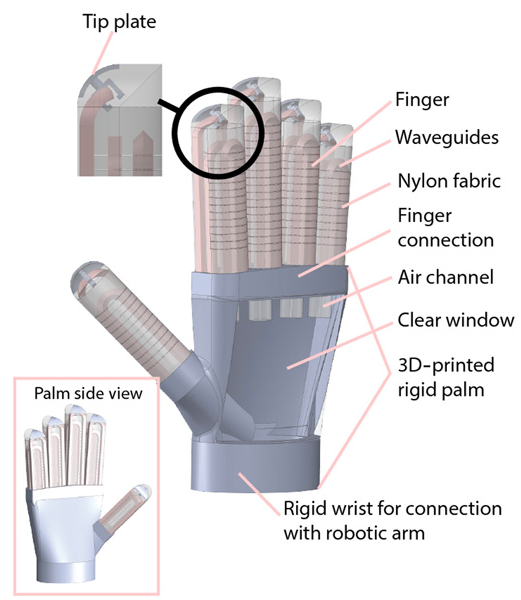A robotic hand with a human’s delicate sense of touch
December 16, 2016

A soft, sensitive robotic hand mounted on a robotic arm (credit: Cornell University)
Cornell University engineers have invented a new kind of robotic hand with a human’s delicate sense of touch.
Scenario: you lost part of your arm in a car accident. That artificial arm and hand you got from the hospital lets you feel and pick up things — even type on a keyboard. But not with the same sensitivity as a real hand. Now, an artificial prosthesis can even let you feel which one of three tomatoes is ripe (as shown in the video below).
The engineers’ trick was to use soft, stretchable optoelectronic (light + electronics) sensors in the fingers to detect shape and texture. (The sensors in existing prosthetic and robot hands use cruder tactile, or touch, sensors with bulky, rigid motors to measure strain.) The new prosthetic hand is a lot more sensitive. It can measure softness or hardness, how much the material stretches when touched, and how much force needs to be supplied to make the material deform.
How to make an (almost) human hand
A Cornell group led by Robert Shepherd, assistant professor of mechanical and aerospace engineering and principal investigator of Organic Robotics Lab, has published a paper describing this research in the debut edition of the journal Science Robotics (open access until Jan. 31).

Schematic of prosthetic hand structure and components (credit: Cornell University)
Unlike existing prosthetic and robot sensors, these sensors are integrated within the hand (instead of on the surface), so they can actually detect forces being transmitted through the thickness of the robot hand — simulating how a human hand feels. The more the prosthetic hand deforms (as it touches an object), the more light is lost. That variable loss of light, as detected by the photodiode, is what allows the prosthetic hand to “sense” its surroundings with high sensitivity and discrimination.*
This work was supported by a grant from Air Force Office of Scientific Research, and made use of the Cornell NanoScale Science and Technology Facility and the Cornell Center for Materials Research, both of which are supported by the National Science Foundation.
* The optoelectronic sensors are based on novel elastomeric optical waveguides, using a 3D-printed mold and a soft-lithography process to create a fluidically powered, stretchable material. Each high-precision waveguide incorporates an LED to generate light and a photodiode to measure the amount of light lost (which depends dynamically on the curvature, elongation, and force of the prosthetic hand).
To make the hand, Shepherd’s group used a four-step soft lithography process to produce the inside of the hand (core) and the cladding (outer surface of the waveguide), which also houses the LED (light-emitting diode) and the photodiode (light detector).
CNBC International | Scientists build a robotic hand with a soft touch | CNBC International
Abstract of Optoelectronically innervated soft prosthetic hand via stretchable optical waveguides
Because of their continuous and natural motion, fluidically powered soft actuators have shown potential in a range of robotic applications, including prosthetics and orthotics. Despite these advantages, robots using these actuators require stretchable sensors that can be embedded in their bodies for sophisticated functions. Presently, stretchable sensors usually rely on the electrical properties of materials and composites for measuring a signal; many of these sensors suffer from hysteresis, fabrication complexity, chemical safety and environmental instability, and material incompatibility with soft actuators. Many of these issues are solved if the optical properties of materials are used for signal transduction. We report the use of stretchable optical waveguides for strain sensing in a prosthetic hand. These optoelectronic strain sensors are easy to fabricate, are chemically inert, and demonstrate low hysteresis and high precision in their output signals. As a demonstration of their potential, the photonic strain sensors were used as curvature, elongation, and force sensors integrated into a fiber-reinforced soft prosthetic hand. The optoelectronically innervated prosthetic hand was used to conduct various active sensation experiments inspired by the capabilities of a real hand. Our final demonstration used the prosthesis to feel the shape and softness of three tomatoes and select the ripe one.